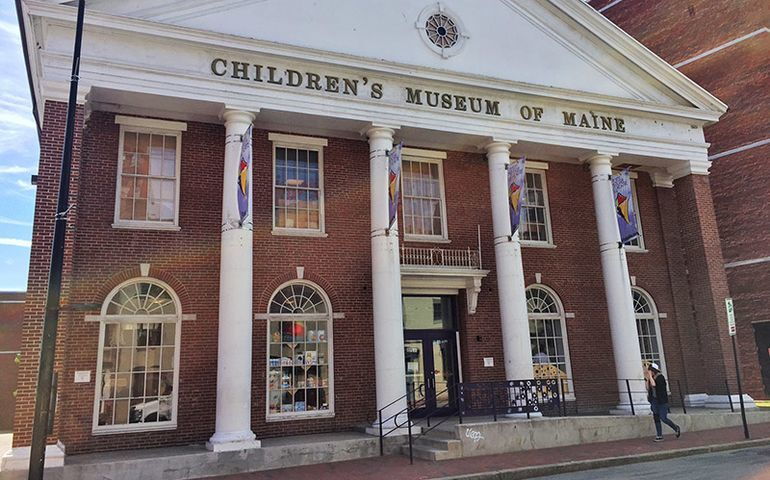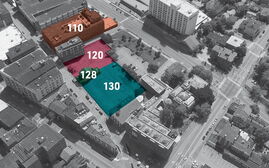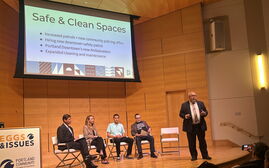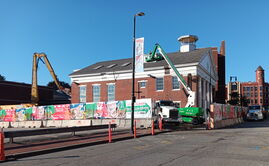
The price of preservation: Portland group opposes museum's plan to raze 'historic' building
 FILE PHOTO / PETER VAN ALLEN
The building at 142 Free St. in Portland dates back to 1830 and was acquired by the Portland Museum of Art in 2019.
FILE PHOTO / PETER VAN ALLEN
The building at 142 Free St. in Portland dates back to 1830 and was acquired by the Portland Museum of Art in 2019.
As part of its sweeping $100 million plan for expansion, the Portland Museum of Art wants to demolish a building next door that dates to 1830 — and recently housed a museum itself until being purchased by the PMA in 2019.
But nine months into the multi-year project, the museum is running into opposition from Greater Portland Landmarks, a historic preservation advocacy group.
The PMA has requested that the Portland Historic Preservation Board reclassify 142 Free St. as a "non-contributing" structure in the Congress Street Historic District, in order to enable development of the new museum building.
However, 142 Free St. “clearly meets the criteria for designation as a contributing structure” and Greater Portland Landmarks “finds no basis for reclassification as a non-contributing structure,” Carol De Tine, vice president of the group's board of trustees, said in a statement to the preservation board.
Past and future
The museum acquired the building from the Children's Museum & Theatre of Maine in 2019, in a transaction that allowed the Children’s Museum to move forward on construction of its new site at Thompson’s Point in Portland. The Thompson’s Point site was completed and opened in 2021.
At the time of the sale, the PMA had no specific plans for its new property, which is directly adjacent to the museum’s Charles Shipman Payson Building at 7 Congress Square. But the PMA said the acquisition provided flexibility for future growth in the densely developed area and would enable the museum to secure space for arts and culture.
In 2022, PMA launched a campus expansion and unification plan, called “The PMA Blueprint,” which includes a proposed new building at 142 Free St.
Earlier this year, after a design competition that drew submissions from over 100 teams in 20 countries, the museum picked LEVER Architecture, based in Los Angeles and Portland, Ore., to lead the project. The firm's proposal calls for a building of mass timber, terracotta and glass, and includes a nod to Maine's Native tribes — the curved roofline is designed to frame the sun as it rises and sets, in honor of Maine’s Wabanaki communities and the land they call Wabanakik, or Dawnland.
The 142 Free St. building was constructed as a theater in 1830 and six years later became the Free Street Baptist Church.
In 1926 it was renovated by Portland architects John Calvin Stevens and John Howard Stevens and later housed the Portland Chamber of Commerce. The Children’s Museum & Theatre of Maine had occupied it for 25 years. The building has long been protected as a contributing structure within the Congress Street Historic District.
The PMA’s application asks the Historic Preservation Board to support reclassifying it as “non-contributing,” which would allow for the building’s demolition if the Portland City Council agrees to the change.
In its application letter, PMA said the building never should have been classified as contributing in 2009 and again in 2020.
"Throughout its lifetime, 142 Free St. has been significantly altered, and is now virtually unrecognizable when compared to previous iterations of the building."
As a result, the museum states in its letter, “we have come to believe it does not contribute to the district historically, nor does it support our city’s innovative vision for the future.”
As an institution itself dating back 140 years, the letter says, the PMA stands ready “to create a new landmark for Portland.”
A rebuild at 142 Free St., the letter says, is critical to the museum's expansion plans and a “catalyst for a brighter future, ensuring Congress Square is a sustainable center for arts and culture.”
Historic debate
According to an analysis commissioned by PMA, the building doesn’t meet standards for historic significance because all of its original interior elements are gone and the building is surrounded by parking lots and the Payson Building, constructed in 1983.
Some of the windows and the main doors are not wood, which compromises materials integrity. And changes to the exterior — including alterations to windows, dormers and cupola — have resulted in “a stronger visual association with the Children’s Museum’s ownership” as compared with its historical predecessors.


But Greater Portland Landmarks argued there is no basis for removing the historical district protections.
“Much hard work and careful consideration goes into establishing a historic district,” said De Tine. “It is critical to maintain the integrity of the district and the buildings within it, as well the city’s historic preservation ordinance. Historic preservation has been a major factor in Portland’s success as a community, and this is no time to let our guard down.”
De Tine said that during a historic district designation process, each structure or site is evaluated in order to assign a classification of contributing, non-contributing or landmark, adding that the same rigorous analysis must be conducted when a request is made to change a classification.
“Changes should only be made when there is ample justification, such as an erroneous classification in the first place or if a building subsequently becomes structurally unsound, neither of which is the case here,” she said.
Since Portland’s historic preservation ordinance was adopted in 1990, about a dozen buildings have been reclassified based on relevant criteria, such as the poor condition of a building.
But the 142 Free St. building, the landmarks group said, is sound and the criteria that led to the building’s original designation as a contributing structure continue to exist.
In its statement to the Historic Preservation Board, Greater Portland Landmarks noted that for a building to be designated as a contributing structure, it needs to meet just one of six criteria laid out in Portland’s Historic Preservation Ordinance. The Free Street building meets four of the criteria, it argued. Among them: "As the former home for nearly 60 years of the city’s chamber of commerce, it expresses and contributes to the theme of the Congress Street Historic District, a cohesive corridor of commercial and civic buildings that are significant for their role in the commercial, social, and architectural development of the city from 1780-1958."
The Historic Preservation Board will hold a workshop on the PMA’s application on Wednesday at 5 p.m. For the agenda, click here.
Mainebiz web partners
There is no longer anything architecturally relevant nor significant about [142 Free Street], despite the building’s history and presence. In a city with limited land availability the highest and best use is for P.M.O.A.’s necessary - and economically beneficial - expansion.














1 Comments